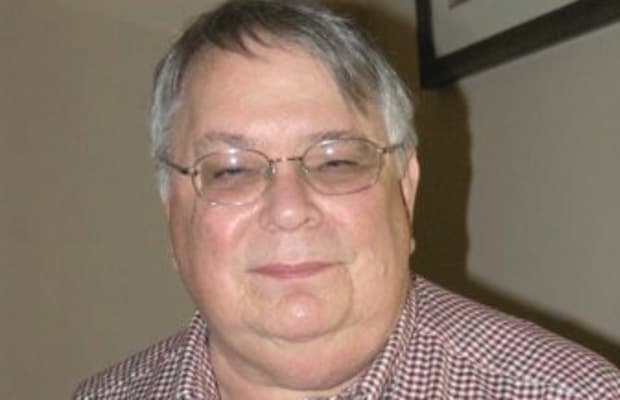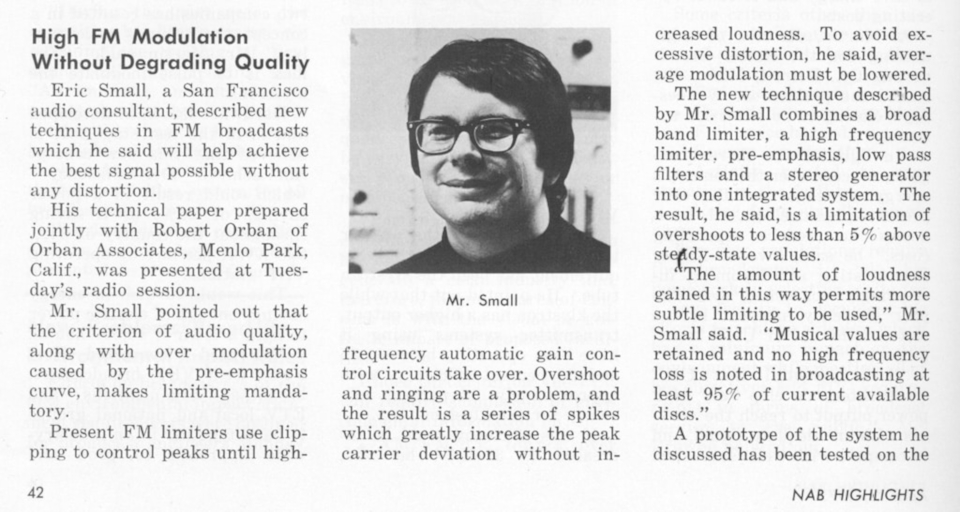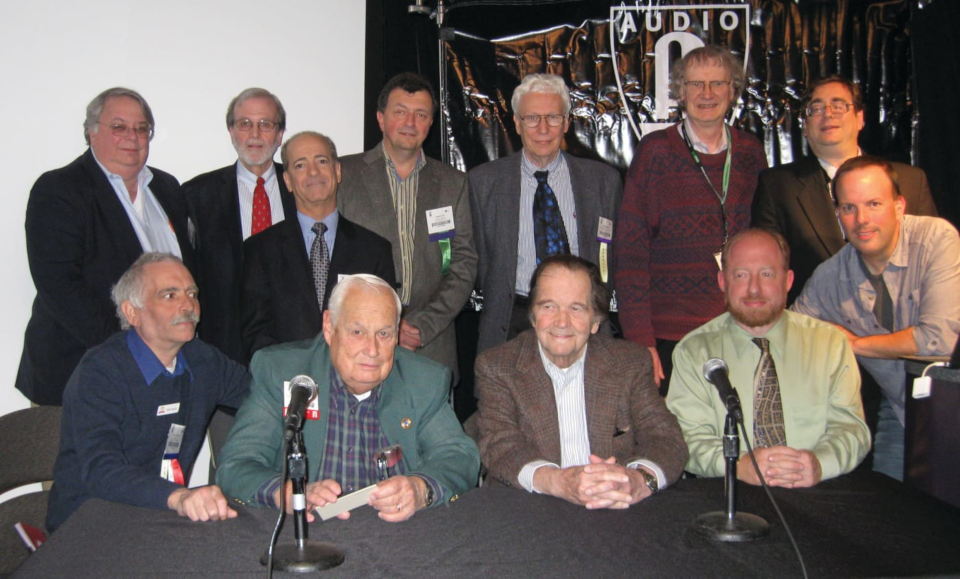Tech Industry Remembers Eric Small
The highlights of Eric Small’s life and career are many. He was a lifelong designer and developer of innovative entertainment technology, including broadcasting and recording.
He was the co-inventor of the game-changing Orban Optimod 8000 FM audio processor.

He held numerous patents and published countless white papers and articles, as well as authored chapters in several editions of the NAB Engineering Handbook.
In the aerospace industry, Small developed the software and hardware for the visual portion of the F/A-18 Hornet combat flight simulator.
Most recently, he participated in the Intelligent Vehicle Highway System initiative, authoring and presenting several papers on highway communications. Small also developed two products for IVHS applications.
But as friends and colleagues took time to reflect on the life of Eric Small, they also recalled personal traits, such as his tenacity, kindness and willingness to help others.
On March 15, Small was leaving a Publix grocery store in Delray Beach, Fla., at 5:09 p.m., when the driver of a car lost control and accelerated towards the store. The car struck Small first and then crashed into the Publix building, according to the Palm Beach Sheriff’s Office report. The driver and Small were transported to Delray Medical Center, where both died from their injuries.
Get the TV Tech Newsletter
The professional video industry's #1 source for news, trends and product and tech information. Sign up below.
Small, who was 71, is survived by wife Roberta; sister Linda and brother-in-law Don Sussman; children Gary Moskoff and Eric Moskoff; daughter-in-law Shannon; and three grandchildren.
EDUCATION AND EARLY CAREER
Small spent most of his youth in and around Brooklyn, N.Y., and began his broadcast career in 1964, at age 17, working for WNCN, a classical music station in New York.
In 1965–66, he attended Shimer College, a Great Books-based curriculum college then located in Mount Carroll, Ill. It was about this time that he met Warner W. Johnston, a fellow Shimer student, lifetime friend and now retired ABC television engineer.
“When I met Eric, he already had his FCC First Class license,” Johnston recalled. “He had some connections in the business and was able to get a console and some audio gear for our college radio station at a discount.”
Johnston recalls that around 1963, Small had won a Westinghouse Science Challenge. His entry involved satellite radio, and the prize included a college scholarship. Shimer was Small’s sole venture into higher education; he only attended for about a year. Johnston adds that although Shimer was a liberal arts college, a surprising number of alumni went on to have careers in science and technology.
For his vast technical knowledge, Small was largely self-educated. “Eric was a voracious reader,” Johnston said. “When we combined our libraries in 1978, he had around 2,400 volumes.”
In 1969, he went to work for A&R Recording as a member of the technical department. While there, he worked under Phil Ramone, considered by many to be one of the most innovative and talented record producers in the industry.
Small was hired in 1972 by New York’s WOR(AM/FM) as chief engineer. The FM soon changed its call sign to WXLO, and his first job was to separate the AM and FM operations, which had been sharing facilities. Small hired Johnston as the second person in the two-man engineering department.

ERIC SMALL ASSOCIATES
In 1974, Small, along with Bob Orban, developed the original Optimod 8000, a revolutionary device in FM audio processing.
Eric Small Associates was founded in San Francisco in 1975, as a base for Small’s broadcast consulting business, and to fulfill a two-year contract with Orban to provide technical support and marketing for the Optimod 8000.
Small also had ideas for products he wanted to develop on his own, but he spent a great deal of time on the road consulting for most of the major radio groups and stations in North America. In 1974 and ’75, Small consulted with CPB on FM SCA subcarrier transmissions, which were growing in use by public radio stations to carry radio reading services and second-language programming.
Eric Small Associates had a staff of seven: Small; Jesse Maxenchs, the marketing manager; John Kean, who handled technical support; two contract engineers who worked on software and hardware development; an office manager and a bookkeeper.
Johnston recalls that at the Eric Small Associates booth at the 1976 NAB Show, there was an attractive young woman, not wearing very much, passing out 8000 fortune cookies inscribed with the fortune: “There is an Optimod in your future.”
Eric Small Associates closed in the summer of 1979. Johnston helped Small load the contents of his firm into a 22-foot Rider truck and the two made a cross-country journey to Brooklyn.
MODULATION SCIENCES
In 1981, Small founded his second company, Modulation Sciences Inc. He remained founder and chief technology officer of MSI until it closed its doors in May 2012.
At the first headquarters, Johnston recalls, Digital Equipment Corp. refused to provide a service contract for his DEC PDP-11 computer because it was located next to a wood-burning stove. The company was originally in Brooklyn and later moved to Somerset, N.J.
Mod Sciences entered the broadcast equipment market with equipment focused on FM signal processing and subcarriers. Its first product was the CP-803 composite processor. Similar devices were on the market but all suffered from the same problem: If pushed too hard, the station’s stereo pilot could be disrupted, inviting citations from the FCC. The innovation of Small’s design was that he found a way to route the pilot around the clipping function, ensuring a means of composite clipping without risking a violation of FCC rules.
Other MSI products of the time included the ModMax, Sidekick FM subcarrier generator, FM ModMinder peak deviation meter and StereoMaxx spatial image enhancer.
By the late 1980s, the company had redirected its energies towards television audio and was active in the development of the BTSC standard for stereo TV sound. MSI’s line of BTSC encoders and test instruments played a key role in bringing stereo audio to analog TV.
In 2011, MSI announced that it would no longer manufacture or support U.S. standards products. Instead, the company redirected its efforts towards the Latin American and Mexican markets, where its ISDB-TB (Integrated Services Digital Broadcasting, Terrestrial, Brazilian version) products had been quite successful.
Throughout his career, Small devoted his energies to the broadcast industry, serving on numerous committees and writing countless white papers, opinion letters and editorials.
ON THE SCA
Small’s interest in FM subcarriers went beyond the technical aspects. He authored the chapter in the CPB Handbook about setting up an SCA-based radio reading service for the blind, and remained an active advocate for them.
Dave Andrews is chief technology officer for the Minnesota Department of Employment and Economic Development. He recalls his first contact and growing friendship with Small.
“I had been trying, unsuccessfully, to find an FM subcarrier that we could use for a radio reading service for the blind in central New Jersey. I got the idea that TV stations also had FM audio and could generate subcarriers. Someone suggested I call Eric and talk to him. He ultimately told me, ‘I don’t think it will work, but I will work with you and try.’
“He did work with us and became a friend, as well as a colleague. We put up the first TV SAP on New Jersey Public TV stations, and it worked great. We modified some UHF Pay TV decoders and got virtually free receivers. Eric was able to use what he learned with me to develop a SAP generator, a TV stereo generator and other television products. These products became the backbone of his company. He also developed the Sidekick, which, simply put, was the best sub-carrier generator that was ever developed,” Andrews said.
Andrews said Small was always supportive of projects that benefitted the blind, the deaf and others. “In the early 2000s, he helped us represent reading services in the standards-setting proceedings for HD Radio, so that existing subcarriers didn’t get wiped out. He also worked with us to try and get DRM, Digital Radio Mondiale, to work on a subcarrier. He was always available with advice, and testing assistance.
“He always had lots of good ideas — and defended them vigorously. Eric also listened to my ideas and thoughts carefully because he knew I was in better touch with the blind community and its needs than he.”
OPTIMOD 8000
It was Small’s work on the Optimod 8000 that brought him to national attention. An Orban company spokesman shared the details of his contributions to that product’s success.
“Eric was involved with Orban in the mid-’70s, in a marketing and technical consulting capacity. When Bob Orban showed him the prototype of the Optimod 8000A, with its non-overshooting lowpass filters, he immediately grasped its potential as an industry game-changer and helped commercialize it by showing Orban, then a studio products company, how to do bullet-proof EMI-resistant packaging and how to get the processor/stereo generator package approved by the FCC by making it look like a composite STL, which the commission had just sanctioned.
“He made innovative technical measurements (using the original CBS Loudness Meter) to prove that it could increase loudness by up to 3 dB over prior approaches, and placed early production units with important industry influencers. He presented technical papers on the concept at industry conferences. Orban is forever grateful to Eric for his tireless efforts to make the 8000A successful, and Orban with it. With his senseless death, the industry has lost a true innovator.”
Not all of Small’s ideas for new products were successful. John Kean, former senior technologist at National Public Radio, recalls his time working for Eric Small Associates in San Francisco. Kean was hired in 1975 as the first technical support engineer for the Optimod 8000, and recalls one of Small’s lesser-known ventures of the time.
“Eric was pursuing a design for an advanced remote control system for broadcast stations. His approach was ahead of the times: It used a DEC LSi-11 computer, programmed in Pascal, supporting many sensors, performing calculated decisions, with a user-friendly GUI. Unfortunately, it took longer to productize than his company could afford, and after two years he had to close up shop, and moved back to New York, after making sure all the staff had secured other jobs first. I always admired his brilliance and his vision, and this job marked a major step in my career. His passing is sad news, but I will always remember him as a great mentor and friend.”

Frank Foti, president of The Telos Alliance, remembers Small for his tenaciousness in defending a cause that he believed in, as well as vast education that extended beyond broadcast topics.
“I was very fortunate to have known Eric on a broader scale. He was truly an innovator, but I really admired his chutzpah. He was well read and educated on many levels.”
Foti remembered attending a National Radio Systems Committee subcommittee meeting where the topic of composite clipping was up for debate.
“I sat with awe, as Eric single-handedly took on all who tried to block the use of the tech. He was not to be denied, and I knew he was right regarding the topic at hand. Afterwards, he invited me out for a bite, and just laughed off the efforts of those who tried to derail him. He just ‘knew’ what was right, and wasn’t going to back down. I learned something that day, and have never forgotten it, in my own ventures.”
Foti remembered conversations with Small and Telos Systems founder Steve Church just to discuss views of the industry and technology.
“Since both Eric and Steve were very academic, those conversations could get a bit ‘heated’ at times, but always with incredible mutual respect for all involved. He was a good friend, and since he got into business long before Steve and I, he was always in our corner, and at times was almost like a big brother to these two ‘radio-rat’ engineers trying to build their own company.”
Shortly after Small closed MSI, he closed up his New York residence and moved with his wife Bobbie and sons to Delray Beach, Fla. It was then that he became interested in intelligent vehicle-highway systems and began to write on the subject and products.
Eric Small was one of a rare breed of engineers who in small numbers are able to move an industry ahead dramatically.
For Small, the genesis of a project often began when others said “it’s impossible” or “it can’t be done.” At the same time, he is remembered for his generosity of spirit, standing up for what he believed in and willingness to help those less fortunate than himself.
